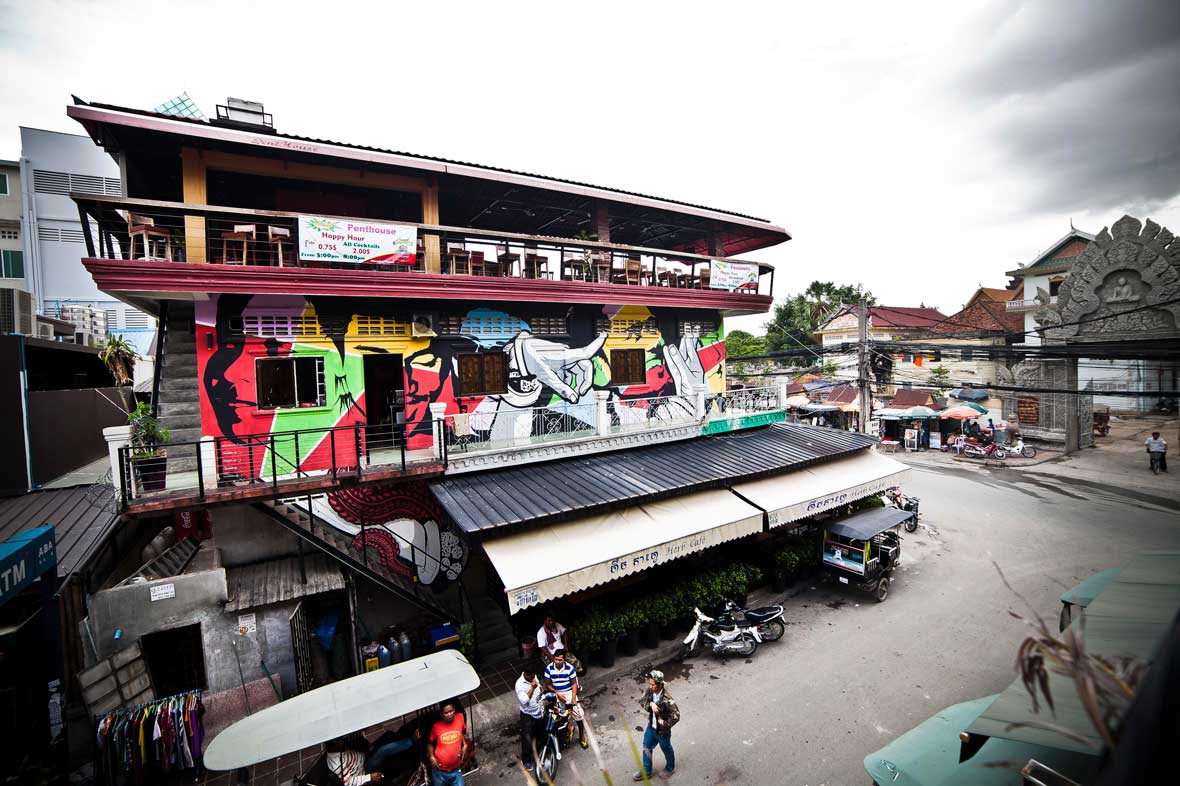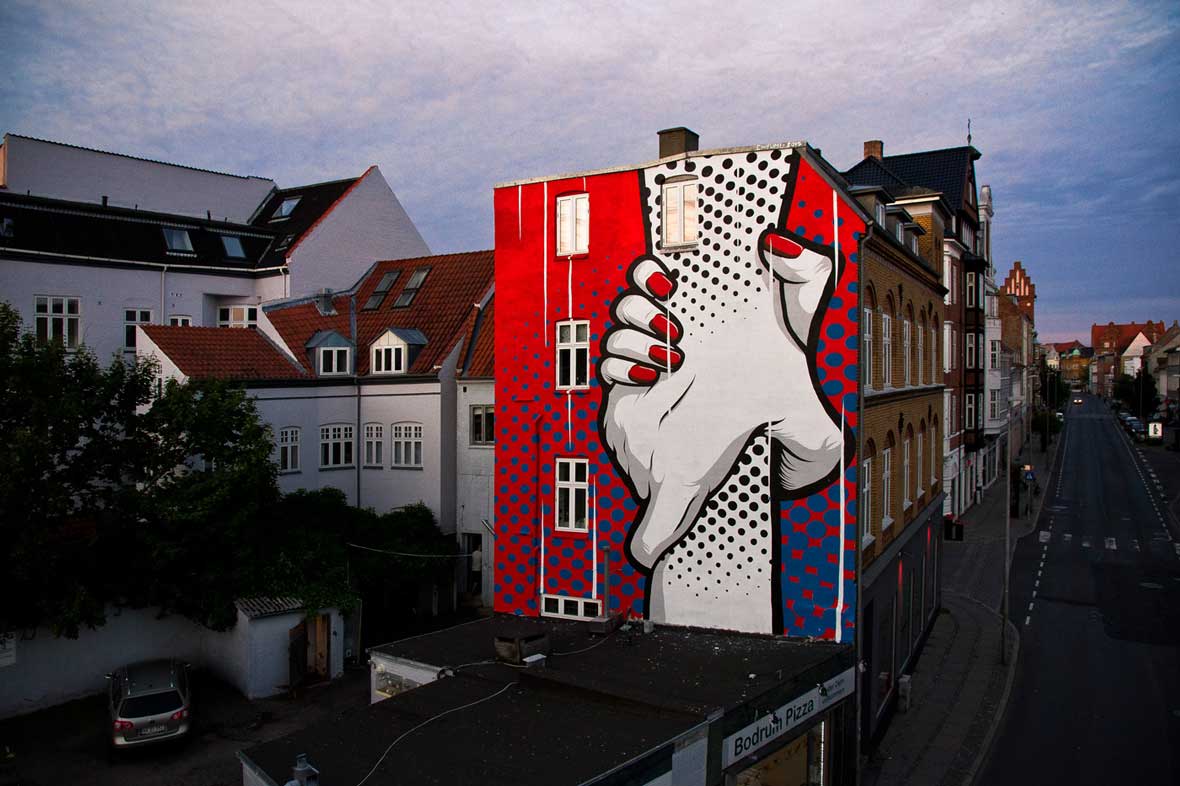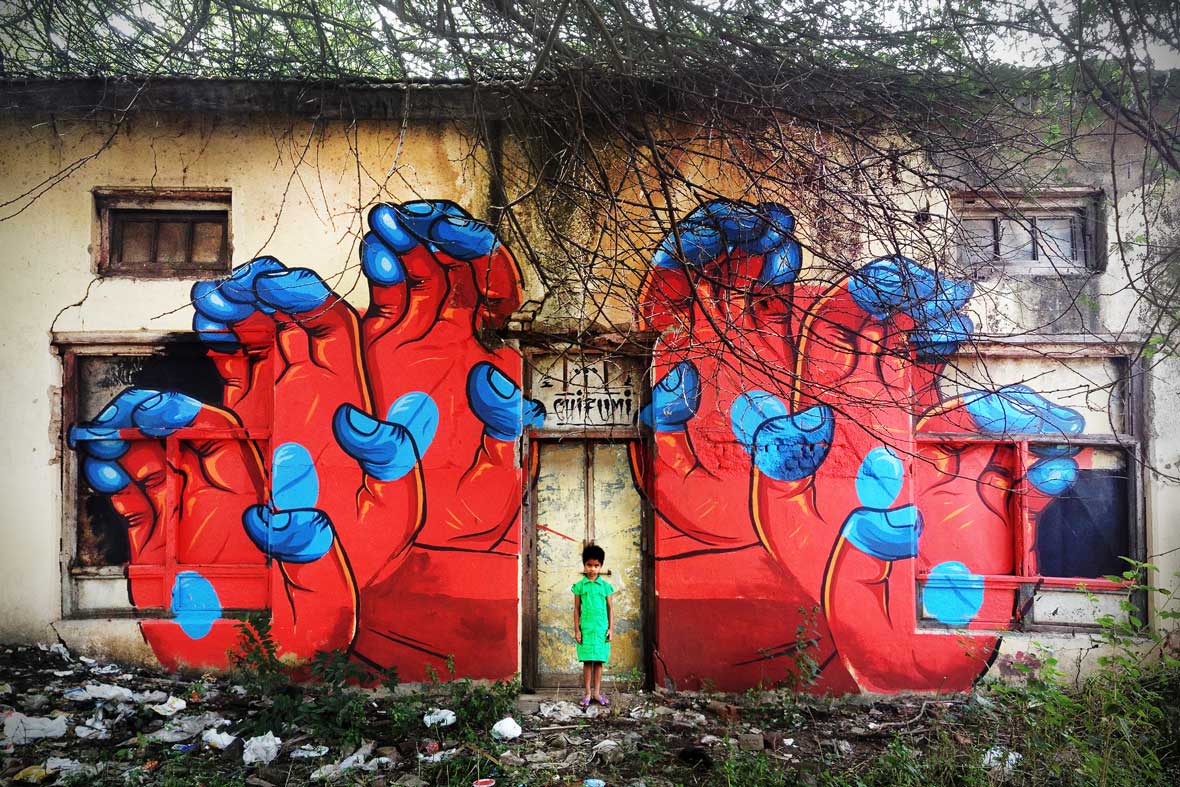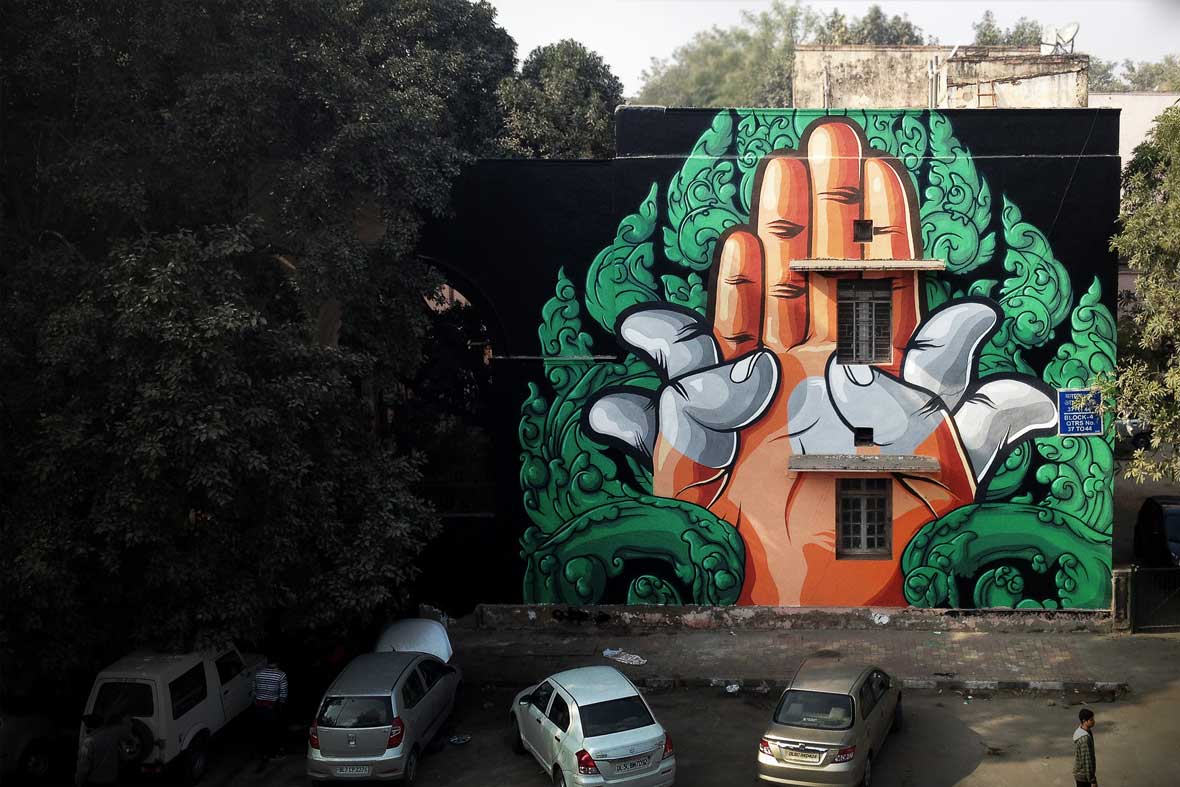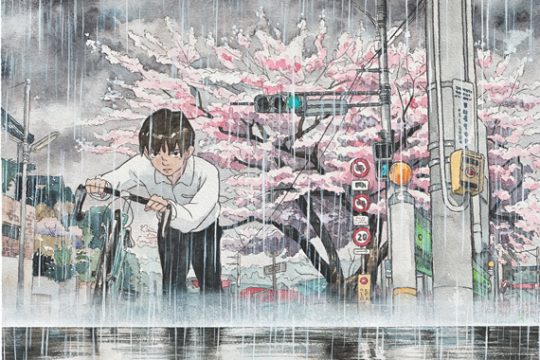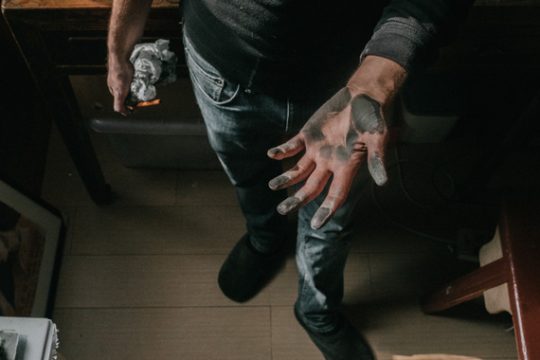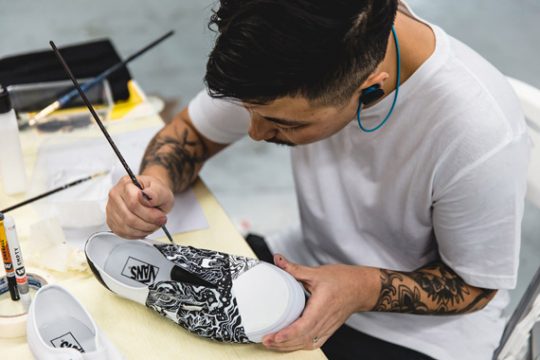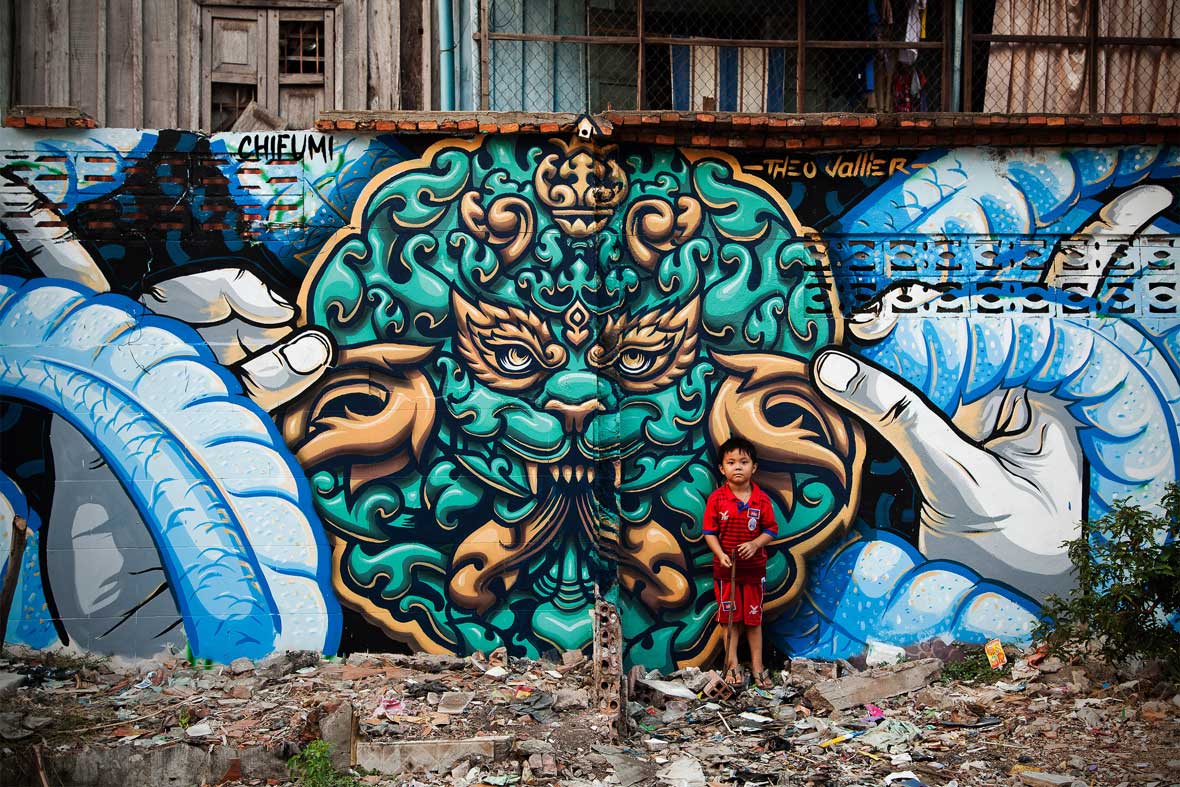
Upon his arrival in Cambodia, Chifumi Tättowiermeister discovered a developing contemporary street art scene in the capital of Phnom Penh. In the last four years, he has become a willing pied piper for young budding Cambodian street artists. Whilst there are no specific laws specifying that street art is illegal in Cambodia, murals are often whitewashed and painted over, even if artists had previously attained permission from the local city hall.
បន្ទាប់ពីគាត់បានមកដល់ប្រទេសកម្ពុជា លោក Chifumi Tättowiermeister បានរកឃើញទីតាំងសិល្បៈតាមដងវិថីបែបសហសម័យដែលកំពុងមានការអភិវឌ្ឍនៅក្នុងរាជធានីភ្នំពេញ។ កាលពីបួនឆ្នាំមុន គាត់បានក្លាយជាអ្នកដឹកនាំដែលប្រកបដោយឆន្ទៈសម្រាប់វិចិត្រករគំនូរតាមដងវិថីវ័យក្មេងដែលពោរពេញដោយទេពកោសល្យនៅក្នុងប្រទេសកម្ពុជា។ ទោះបីជាពុំមានច្បាប់ច្បាស់លាស់ណាមួយដែលបញ្ជាក់ថាសិល្បៈតាមដងវិថី គឺជាអំពើខុសច្បាប់នៅក្នុងប្រទេសកម្ពុជាក៏ដោយ ក៏គំនូរនៅលើជញ្ជាំងតែងតែត្រូវបានគេលុបដោយទឹកថ្នាំពណ៌ ស និងលាបថ្នាំជញ្ជាំង ទោះបីជាវិចិត្រករធ្លាប់ទទួលបានការអនុញ្ញាតិពីសាលាក្រុងក្នុងមូលដ្ឋានពីមុនមកក៏ដោយ។
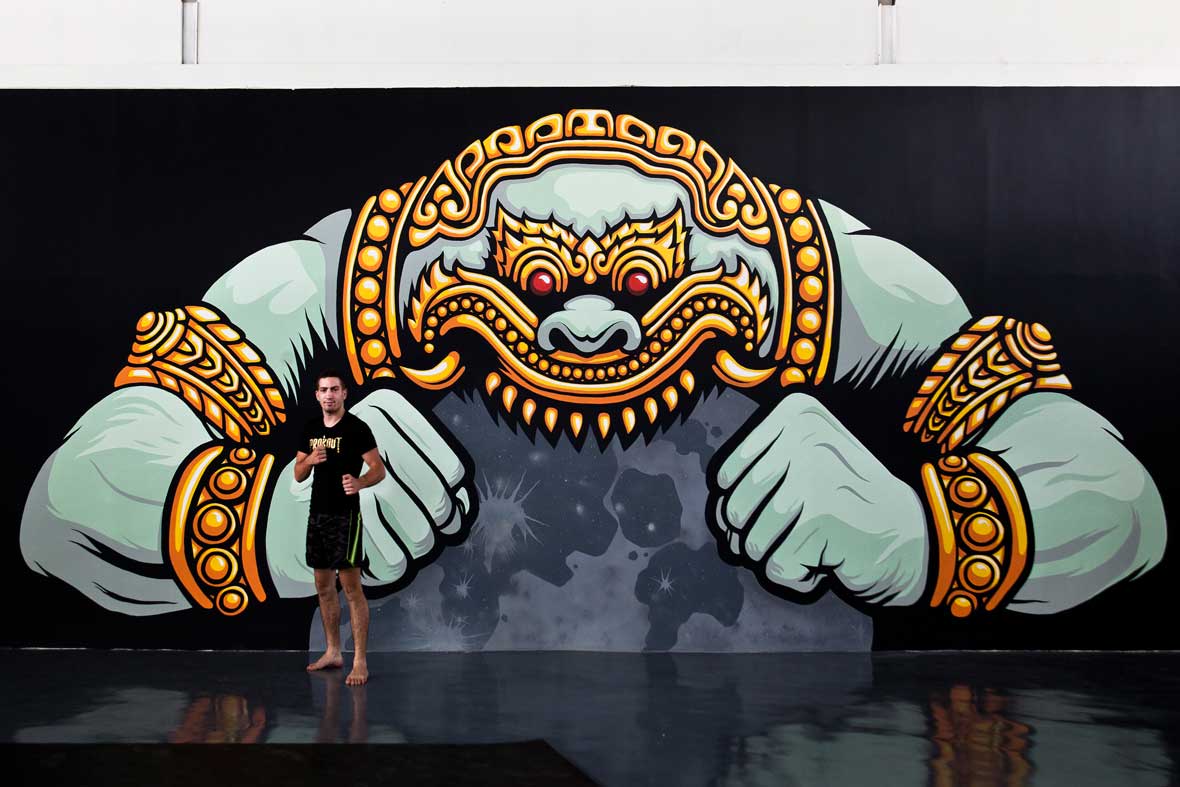
In recent years, local government bodies have become more receptive to street art, especially if they’re promoting traditional Khmer culture or positive social messages. With this in mind, Chifumi draws inspiration from the local Cambodian society for his eye-catching murals that boldly celebrate the colours and culture of his new found home. Neocha caught up with Chifumi recently to learn more about his current projects and his involvement in this year’s Cambodia Urban Art Festival.
អង្គភាពរបស់រដ្ឋាភិបាលក្នុងមូលដ្ឋានកាន់តែអាចទទួលយកបាននូវសិល្បៈតាមដងវិថីនេះ ហើយ ប្រសិនបើពួកគេធ្វើការលើកតម្កើងវប្បធម៌ប្រពៃណីខ្មែរ ឬសារវិជ្ជមាននៅក្នុងសង្គម។ ដោយប្រកាន់ខ្ជាប់នូវទស្សនៈបែបនេះនៅក្នុងចិត្ត Chifumi បានទាញយកការបំផុសគំនិតពីសង្គមកម្ពុជានៅក្នុងមូលដ្ឋានសម្រាប់ការគួររូបលើជញ្ជាំងដែលគួរឲ្យទាក់ទាញភ្នែករបស់គាត់ ដែលកត់សម្គាល់យ៉ាងច្បាស់លាស់នូវពណ៌ និងវប្បធម៌នៃផ្ទះថ្មីដែលគាត់បានទៅដល់។ Neocha បានទៅជួបជាមួយ Chifumi នាពេលថ្មីៗនេះដើម្បីធ្វើការរៀនសូត្របន្ថែមអំពីគម្រោងបច្ចុប្បន្នរបស់គាត់ និងការចូលរួមរបស់គាត់នៅក្នុងទិវាសិល្បៈខាងក្រៅនៃប្រទេសកម្ពុជានៅក្នុងឆ្នាំនេះ។
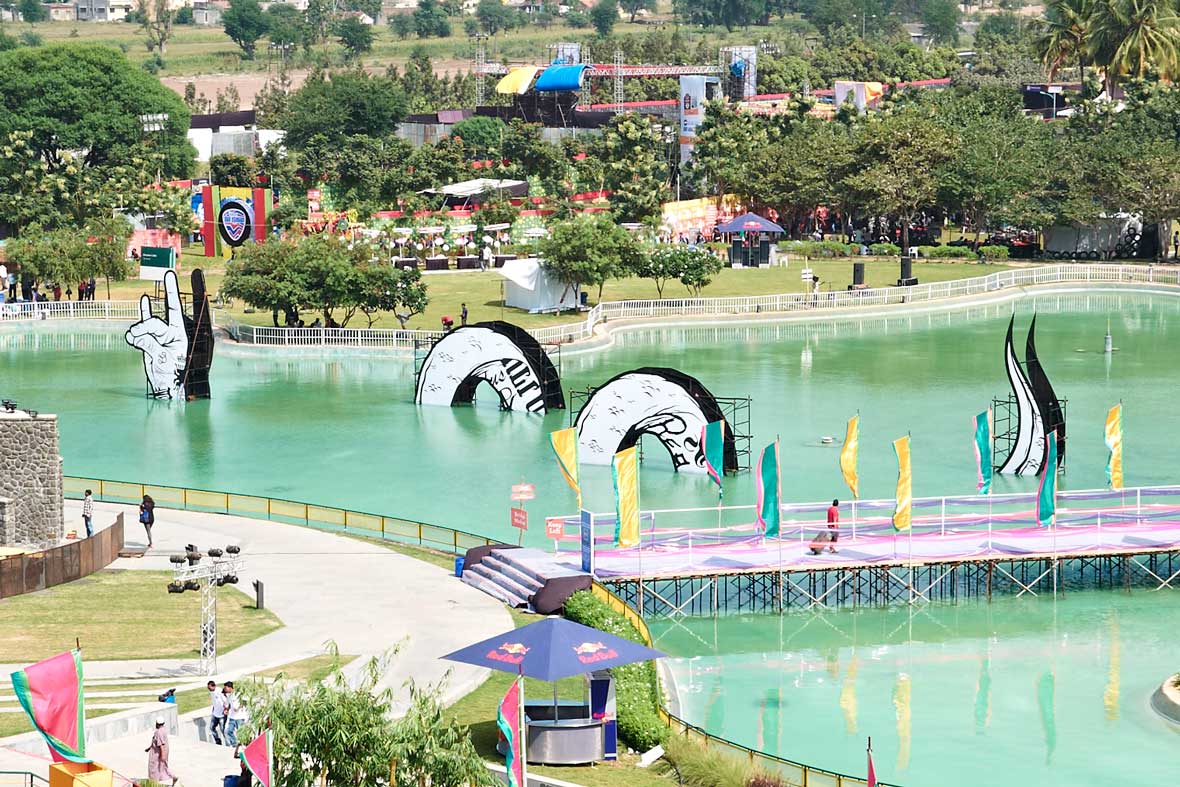
Neocha: What is the creative process behind your amazing murals?
Chifumi: Whenever I’m out looking for a wall to do my next mural, I pay attention to every detail. For me, the social and cultural background of the city in which I’m painting in is just as important as the architectural space itself. I always create a sketch before I actually start painting; it is always as if the local context of each city feeds into my work. Living in Southeast Asia allows me to incorporate local mythology and culture as graphic elements in my work. I’m always on the road, so I usually have water-based acrylic paint with my own brushes and rolls handy – it’s not always possible to find good quality graffiti spray cans where I am.
Neocha: តើអ្វីគឺជាដំណើរការប្រកបដោយភាពច្នៃប្រឌិតដែលនៅពីក្រោយរូបគំនូរលើជញ្ជាំងដ៏អស្ចារ្យរបស់លោក?
Chifumi: នៅគ្រប់ពេលដែលខ្ញុំចេញទៅខាងក្រៅដើម្បីស្វែងរកជញ្ជាំងណាមួយដើម្បីគូររូបគំនូរលើជញ្ជាំងបន្ទាប់ទៀតរបស់ខ្ញុំ ខ្ញុំតែងតែយកចិត្តទុកដាក់លើគ្រប់ចំណុចលម្អិតទាំងអស់។ សម្រាប់ខ្ញុំ សាវតារផ្នែកសង្គម និងវប្បធម៌របស់ទីក្រុងដែលខ្ញុំកំពុងតែធ្វើការគូររូបគឺមានសារៈសំខាន់ដូចគ្នាទៅនឹងផ្ទៃលំហផ្នែកស្ថាបត្យកម្មរបស់ទីក្រុងនោះផងដែរ។ ខ្ញុំតែងតែធ្វើការព្រាងរូបគំនូរមួយមុនពេលដែលខ្ញុំចាប់ផ្តើមធ្វើការគូររូបគំនូរពិតប្រាកដ គឺហាក់បីដូចជាបរិបទក្នុងមូលដ្ឋានរបស់ទីក្រុងនីមួយៗត្រូវបានរួមបញ្ចូលទៅក្នុងការងាររបស់ខ្ញុំ។ ការរស់នៅអាស៊ីអាគ្នេយ៍បានធ្វើឲ្យខ្ញុំអាចរួមបញ្ចូលទេវកថា-វិទ្យា និងវប្បធម៌ក្នុងមូលដ្ឋានជាក្រាហ្វិកចូលទៅក្នុងការងាររបស់ខ្ញុំ។ ខ្ញុំតែងតែនៅតាមដងវិថី ដូច្នេះជាធម្មតាខ្ញុំមានទឹកថ្នាំពណ៌ដែលមានសារធាតុអាគ្រីលីកដែលផ្អែកលើកម្រិតទឹករួមជាមួយច្រាសផ្ទាល់ខ្លួនរបស់ខ្ញុំ និងលាបថ្នាំដោយការរុញដោយដៃ – ខ្ញុំមិនមែនតែងតែអាចរកបានកំប៉ុងបាញ់ទឹកថ្នាំរូបគំនូរលើជញ្ជាំងដែលមានគុណភាពល្អនៅកន្លែងដែលខ្ញុំរស់នៅនោះទេ។
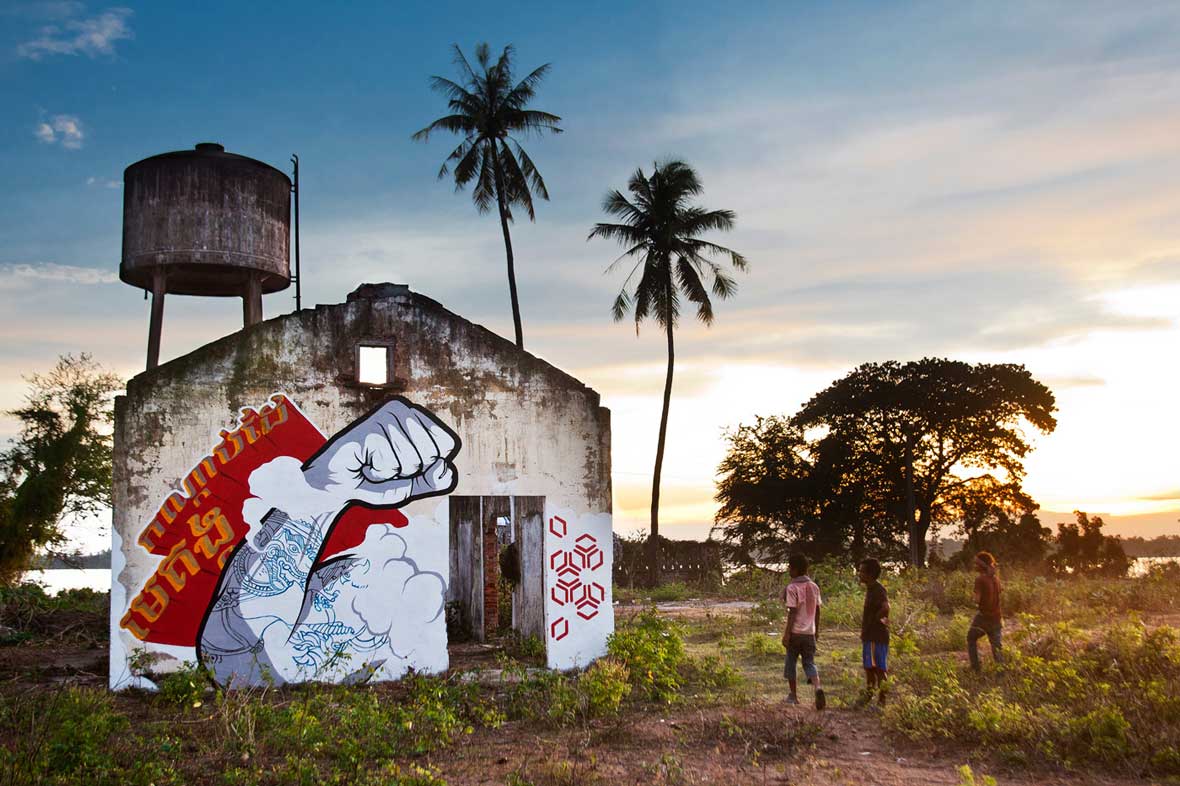
Neocha: What brought you to Cambodia? What drew you to the art scene here?
Chifumi: Four years ago, I started a project for a French media platform that documented my journey from India to Australia and I continuously made art along the way. Unfortunately, before its completion, the project came to an abrupt end whilst I was traveling through Southeast Asia. I have been living in Cambodia ever since – it was a difficult time, but I still have so many great memories about my arrival in Phnom Penh. There was no real prominent street art scene and only a few street artists around when I arrived. So, I worked hard. I tried really hard to bring something cool and artistic to this city. Looking back now, it was a really great feeling.
Neocha: តើអ្វីដែលជម្រុញរូបលោកឲ្យមកកាន់ប្រទេសកម្ពុជា? តើអ្វីទាក់ទាញលោកឲ្យមានចំណាប់អារម្មណ៍មកលើឆាកសិល្បៈនៅទីនេះ?
Chifumi: កាលពីបួនឆ្នាំមុន ខ្ញុំបានចាប់ផ្តើមគម្រោងមួយសម្រាប់វេទិកាប្រព័ន្ធផ្សព្វផ្សាយរបស់ប្រទេសបារាំងដែលបានចងក្រងឯកសារអំពីការធ្វើដំណើររបស់ខ្ញុំពីប្រទេសឥណ្ឌាទៅកាន់ប្រទេសអូស្រ្តាលី ខ្ញុំបានបង្កើតសិល្បៈជាបន្តបន្ទាប់នៅក្នុងអំឡុងពេលនៃការធ្វើដំណើររបស់ខ្ញុំ។ ជាអកុសល មុនពេលដែលគម្រោងត្រូវបានបញ្ចប់យ៉ាងពេញលេញ គម្រោងនេះត្រូវបានបញ្ចប់ភ្លាមៗខណៈពេលដែលខ្ញុំកំពុងធ្វើដំណើរឆ្លងកាត់អាស៊ីអាគ្នេយ៍។ ខ្ញុំបានរស់នៅក្នុងប្រទេសកម្ពុជាចាប់តាំងពីពេលនោះមក – វាគឺជាពេលវេលាដ៏លំបាកមួយ ប៉ុន្តែខ្ញុំនៅតែមានការចងចាំដ៏អស្ចារ្យជាច្រើនអំពីការមកដល់ទីក្រុងភ្នំពេញ។វាពុំមានទីតាំងសិល្បៈតាមដងវិថីដែលគួរឲ្យចាប់អារម្មណ៍យ៉ាងពិតប្រាកដនោះទេ និងមានវិចិត្រកររូបគំនូរតាមដងវិថីតែពីរឬបីនាក់ប៉ុណ្ណោះនៅពេលដែលខ្ញុំបានមកដល់នោះ។ ដូច្នេះ ខ្ញុំបានធ្វើការខិតខំប្រឹងប្រែងយ៉ាងខ្លាំង ខ្ញុំបានព្យាយាមយ៉ាងខ្លាំងក្នុងការនាំយកអ្វីដែលមានភាពស៊ីវិល័យ និងមានលក្ខណៈសិល្បៈមកកាន់ទីក្រុងនេះ។ រំឮកឡើងវិញនៅពេលនេះ វាពិតជាអារម្មណ៍ដ៏អស្ចារ្យមួយ។
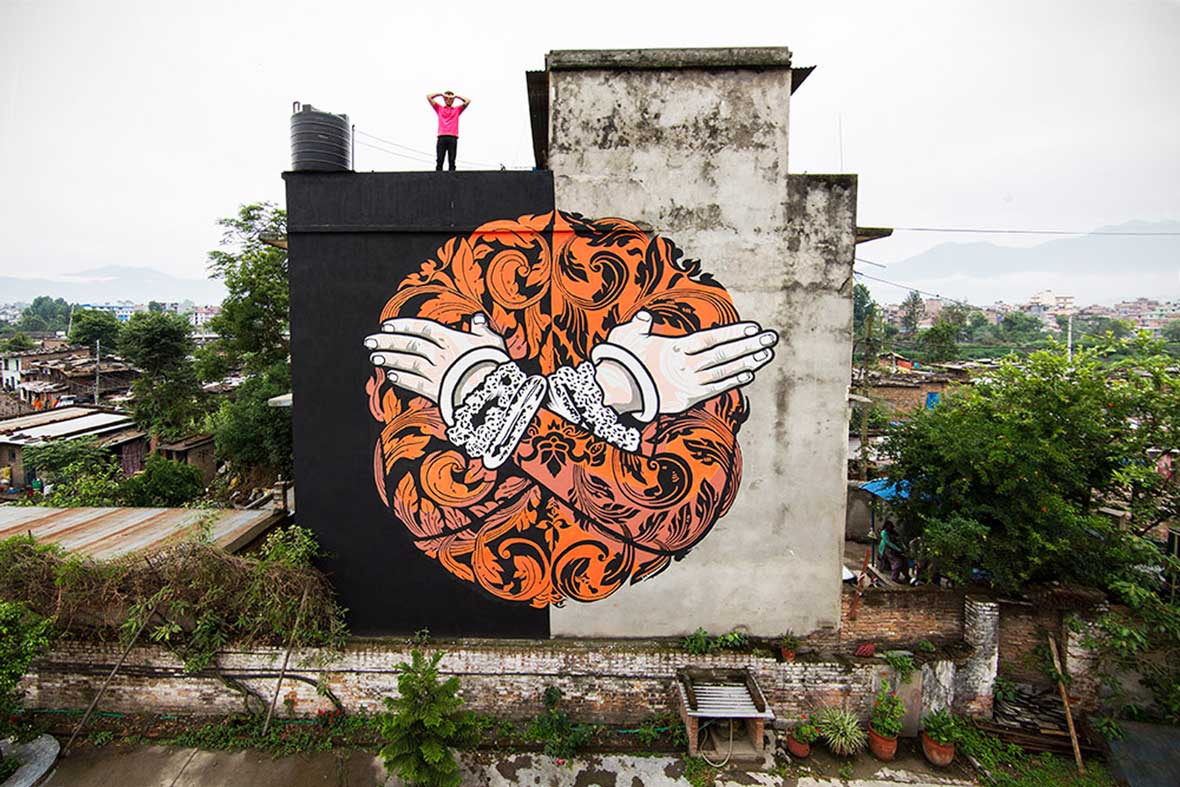
Neocha: You are the artistic director for the Cambodia Urban Art Festival 2016. What was it like to bring 14 artists together to showcase their work across Phnom Penh?
Chifumi: After residing in Phnom Penh for the last few years, I was determined to unify the graffiti and street art scene here, and I thought that the best way to do it would be to create a fun event that gave Cambodian youths a rich insight into this artistic culture. So, I decided to bring local artists and international painters together; the festival included artists of ten different nationalities and we hoped they would bring some fresh colours into Phnom Penh. It was so important for us to reference the local culture and context in these projects; once all of the murals were done, we organised a tour across the city with 50 free tuk-tuks. We even had a few local hip-hop artists performing at some of the venues; I’m elated that this project happened and I truly think that the Cambodian youth were really able to gain something from it.
Neocha: លោកគឺជាប្រធានផ្នែកសិល្បៈសម្រាប់ទិវាសិល្បៈខាងក្រៅនៃប្រទេសកម្ពុជា ឆ្នាំ 2016 –តើវាមានលក្ខណៈយ៉ាងដូចម្តេចដែរក្នុងការប្រមូលផ្តុំវិចិត្រករចំនួន 14 រូបឲ្យមកជួបជុំគ្នាដើម្បីធ្វើបទបង្ហាញអំពីការងាររបស់ពួកគេនៅទូទាំងទីក្រុងភ្នំពេញ?
Chifumi: បន្ទាប់ពីបានស្នាក់នៅក្នុងទីក្រុងភ្នំពេញបានពីរបីឆ្នាំ ខ្ញុំបានសម្រេចចិត្តធ្វើការបង្រួបបង្រួមការគូររូបគំនូរនៅលើជញ្ជាំង និងឆាកសិល្បៈតាមដងវិថីនៅទីនេះ ហើយខ្ញុំគិតថា វិធីសាស្រ្តដែលល្អបំផុតសម្រាប់ការធ្វើការបង្រួបបង្រួមនេះ អាចជាការបង្កើតព្រឹត្តិការណ៍កំសាន្តដែលផ្តល់ជូនយុវជនកម្ពុជានូវការយល់ដឹងយ៉ាងច្បាស់អំពីវប្បធម៌សិល្បៈនេះ។ ដូច្នេះ ខ្ញុំបានសម្រេចចិត្តនាំយកវិចិត្រករនៅក្នុងមូលដ្ឋាន និងអ្នកគូររូបអន្តរជាតិឲ្យមកធ្វើការជាមួយគ្នា។ ទិវានេះបានរួមបញ្ចូលវិចិត្រករដែលមានសញ្ជាតិខុសៗគ្នាជាង 10 ដើម្បីពាំនាំមកនូវពណ៌ស្រស់ស្រាយមួយចំនួនមកកាន់ទីក្រុងភ្នំពេញ។ ការយោងដល់វប្បធម៌ក្នុងមូលដ្ឋាន និងបរិបទក្នុងគម្រោងទាំងនេះក៏មានសារៈសំខាន់ចំពោះយើងផងដែរ។ បន្ទាប់ពីយើងគូររូបគំនូរលើជញ្ជាំងទាំងអស់រួចរាល់ហើយ យើងបានរៀបចំការធ្វើដំណើរជុំវិញទីក្រុងដោយការធ្វើដំណើរតាមរ៉ឺម៉កកង់បីចំនួន 50 ដោយឥតគិតថ្លៃ។ យើងក៏មានសិល្បករហ៊ីបហប់(hip-hop) មួយចំនួនតូចដែលធ្វើការសម្តែងនៅទីកន្លែងមួយចំនួនផងដែរ។ ខ្ញុំមានក្តីរំភើបរីករាយដែលគម្រោងនេះបានកើតឡើង ហើយខ្ញុំពិតជាគិតថា យុវជនកម្ពុជាពិតជាអាចទទួលបានចំណេះដឹងមួយចំនួនពីគម្រោងនេះ។
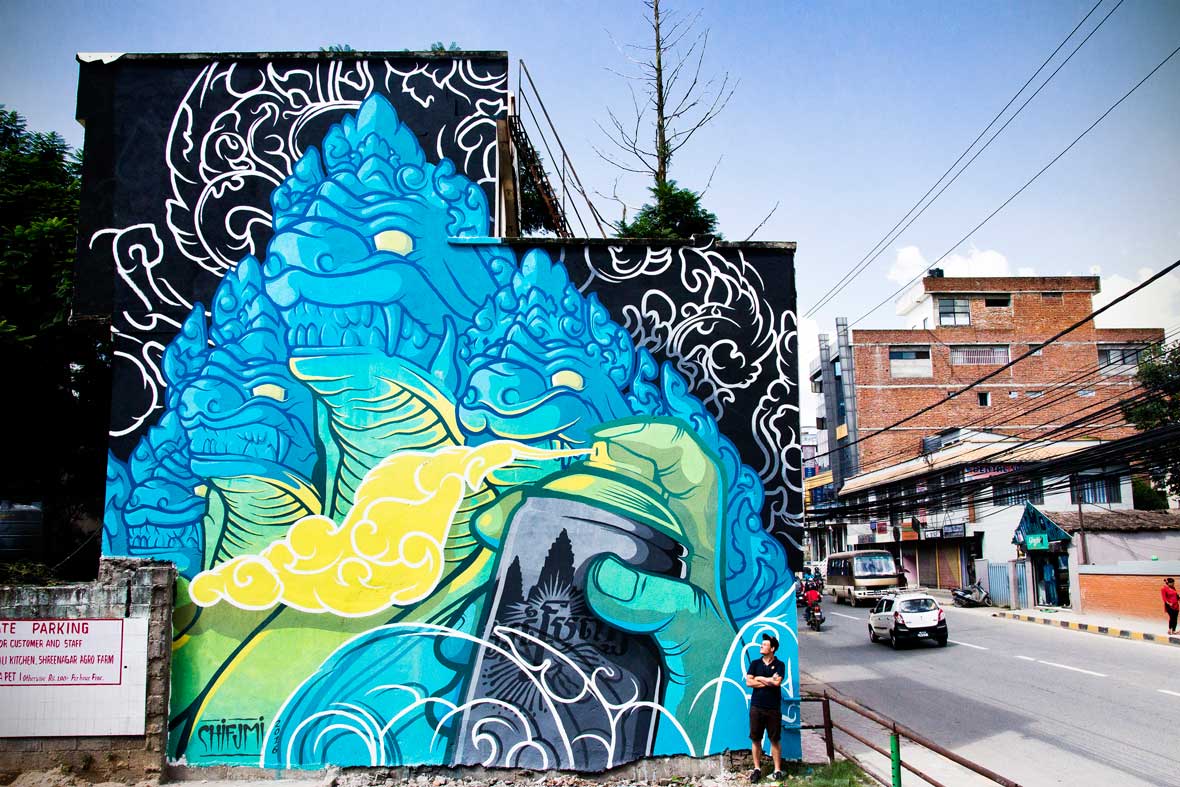
Neocha: What are some of the other upcoming projects that you have around Asia?
Chifumi: Recently, I attended the PRASAD Festival in Nepal. I actually painted a giant mural in Kathmandu before the 2015 earthquake, so I felt compelled to return and share some colours with the local people. I feel like the street art scene in Nepal is much like Cambodia, as in it’s very young. But I see a lot of opportunities and hope in these artists who are working hard to develop their own style and energy. My next few projects will be situated in Pakistan, India, Indonesia and Malaysia, but I’ll also continuously working from Phnom Penh – Asia keeps artists very busy sometimes!
Neocha: តើមានគម្រោងអ្វីផ្សេងទៀតដែលលោកនឹងធ្វើឡើងនៅជុំវិញទ្វីបអាស៊ីនាពេលខាងមុខ?
Chifumi; នាពេលថ្មីៗនេះ ខ្ញុំបានចូលរួមទិវា PRASAD នៅប្រទេសនេប៉ាល់ – ជាក់ស្តែង ខ្ញុំបានគូររូបគំនូរលើជញ្ជាំងដ៏ធំមួយនៅ Kathmandu មុនពេលមានការរញ្ជូយដីនៅក្នុងឆ្នាំ 2015 ដូច្នេះខ្ញុំមានអារម្មណ៍ថា ខ្ញុំត្រូវបានគេបង្ខំឲ្យត្រឡប់ទៅទីនោះវិញដើម្បីចែករំលែកពណ៌មួយចំនួនជាមួយប្រជាជនក្នុងមូលដ្ឋាន។ ខ្ញុំមានអារម្មណ៍ថា ឆាកសិល្បៈតាមដងវិថីនៅប្រទេសនេប៉ាល់ គឺដូចគ្នានឹងឆាកសិល្បៈតាមដងវិថីនៅប្រទេសកម្ពុជាខ្លាំងណាស់ គឺនៅក្មេងខ្ចីខ្លាំងណាស់ – ប៉ុន្តែខ្ញុំមើលឃើញឱកាសជាច្រើន និងមានក្តីសង្ឃឹមយ៉ាងខ្លាំងចំពោះវិចិត្រករទាំងនេះដែលកំពុងខិតខំប្រឹងប្រែងអភិវឌ្ឍរចនាបថផ្ទាល់ខ្លួន និងថាមពលរបស់ពួកគេ។ គម្រោងមួយចំនួនតូចបន្ទាប់ទៀតរបស់ខ្ញុំនឹងធ្វើឡើងនៅប្រទេសប៉ាគីស្ថាន ប្រទេសឥណ្ឌា ប្រទេសឥណ្ឌូនេស៊ី និងប្រទេសម៉ាឡេស៊ី ព្រមទាំងការធ្វើការងារជាបន្តបន្ទាប់នៅទីក្រុងភ្នំពេញ។ នៅពេលខ្លះ ទ្វីបអាស៊ីធ្វើឲ្យវិចិត្រករទាំងឡាយមានភាពមមាញឹកខ្លាំងណាស់!
Neocha: Where do you hope that your art can take you in the future?
Chifumi: I feel that every painting I do is more for myself than for the sake of being remembered. Each mural is a personal challenge that I have to surpass. For contemporary street artists now, the lifestyle is intense. You are always invited to travel and put your mark onto many new places. All of my travels change and influence my artworks, allowing me to put different shapes and colours into play. With every new culture that I immerse myself into, it always gives me the energy to create more. I hope that my art will continue to take me on the road again and again in the future, and I also hope that my art will stay free in public spaces and won’t be locked into the cage of a gallery or museum space.
Neocha: តើអ្នកសង្ឃឹមថា សិល្បៈរបស់អ្នកនឹងនាំអ្នកទៅកាន់ទីណានៅពេលអនាគត?
Chifumi: ខ្ញុំមានអារម្មណ៍ថា គ្រប់រូបគំនូរដែលខ្ញុំគូរ គឺខ្ញុំគូរវាឡើងសម្រាប់ខ្លួនខ្ញុំច្រើនជាងសម្រាប់ការចងចាំរបស់អ្នកទាំងអស់គ្នា – រូបគំនូរលើជញ្ជាំងនីមួយៗ គឺជាការប្រកួតប្រជែងផ្ទាល់ខ្លួនដែលខ្ញុំត្រូវតែធ្វើឲ្យកាន់តែល្អឡើង។ សម្រាប់វិចិត្រកររូបគំនូរតាមដងវិថីបែបសហសម័យនាពេលបច្ចុប្បន្ន ពួកគេមានការផ្តោតយ៉ាងខ្លាំងទៅលើរចនាបថនៃជីវិត – អ្នកតែងតែត្រូវបានគេអញ្ជើញឲ្យធ្វើដំណើរ និងធ្វើការកត់សម្គាល់ទីកន្លែងថ្មីៗជាច្រើន។ រាល់ការធ្វើដំណើររបស់ខ្ញុំបានផ្លាស់ប្តូរ និងបានជះឥទ្ធិពលដល់កិច្ចការសិល្បៈរបស់ខ្ញុំ ដែលធ្វើឲ្យខ្ញុំអាចបង្កើតទ្រង់ទ្រាយខុសៗគ្នា និងដាក់ពណ៌ខុសៗគ្នានៅក្នុងសកម្មភាពនានា។ ជាមួយនឹងវប្បធម៌ថ្មីៗដែលខ្ញុំបានចុះទៅសិក្សាដោយផ្ទាល់ វាតែងតែធ្វើឲ្យខ្ញុំមានថាមពលក្នុងការបង្កើតអ្វីៗថ្មីៗបន្ថែមទៀត។ ខ្ញុំសង្ឃឹមថា សិល្បៈរបស់ខ្ញុំនឹងបន្តធ្វើឲ្យខ្ញុំអាចស្ថិតនៅតាមដងវិថីម្តងហើយម្តងទៀតនៅពេលអនាគត ហើយខ្ញុំក៏សង្ឃឹមផងដែរថា សិល្បៈរបស់ខ្ញុំនឹងស្ថិតនៅយ៉ាងមានសេរីភាពនៅទីតាំងសាធារណៈ និងមិនត្រូវបានចាក់សោរទុកនៅក្នុងទ្រុងនៃវិចិត្រសាល ឬទីតាំងណាមួយនៃសារមន្ទីរឡើយ។
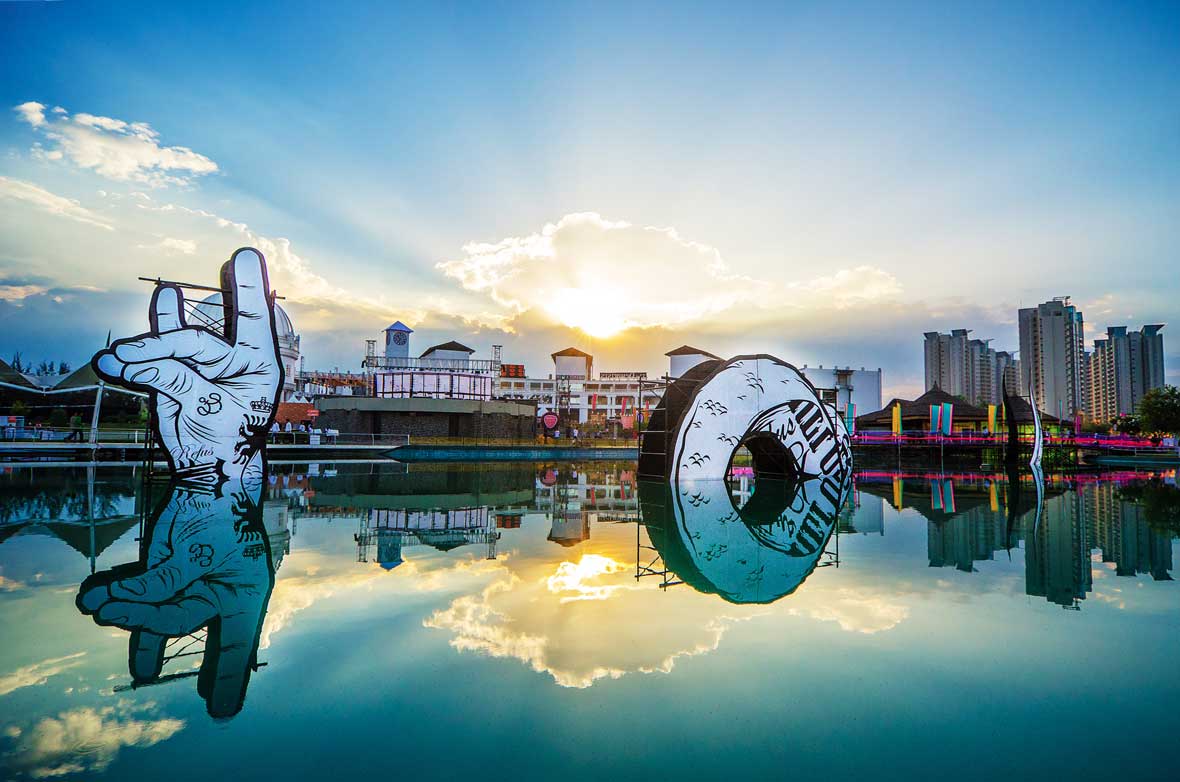
Website: chifumi.fr
Facebook: ~/chifumistreetart
Contributor: Whitney Ng
Images Courtesy of Chifumi Tättowiermeister
Website: chifumi.fr
Facebook: ~/chifumistreetart
អ្នកជំនួយ: Whitney Ng
មានការអនុញ្ញាតពី រូបថត: Chifumi Tättowiermeister


